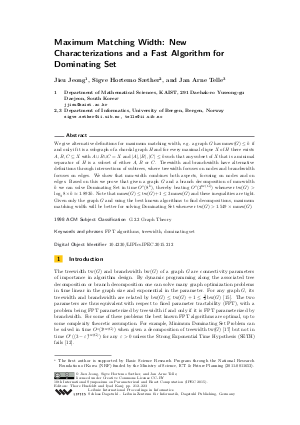Maximum Matching Width: New Characterizations and a Fast Algorithm for Dominating Set
Authors Jisu Jeong, Sigve Hortemo Sæther, Jan Arne Telle
-
Part of:
Volume:
10th International Symposium on Parameterized and Exact Computation (IPEC 2015)
Part of: Series: Leibniz International Proceedings in Informatics (LIPIcs)
Part of: Conference: International Symposium on Parameterized and Exact Computation (IPEC) - License:
 Creative Commons Attribution 3.0 Unported license
Creative Commons Attribution 3.0 Unported license
- Publication Date: 2015-11-19
File

PDF
LIPIcs.IPEC.2015.212.pdf
- Filesize: 0.5 MB
- 12 pages
Document Identifiers
Subject Classification
Keywords
- FPT algorithms
- treewidth
- dominating set
Metrics
- Access Statistics
-
Total Accesses (updated on a weekly basis)
0Document
0Metadata
Abstract
We give alternative definitions for maximum matching width, e.g., a graph G has mmw(G) <= k if and only if it is a subgraph of a chordal graph H and for every maximal clique X of H there exists A,B,C \subseteq X with A \cup B \cup C=X and |A|,|B|,|C| <= k such that any subset of X that is a minimal separator of H is a subset of either A, B or C. Treewidth and branchwidth have alternative definitions through intersections of subtrees, where treewidth focuses on nodes and branchwidth focuses on edges. We show that mm-width combines both aspects, focusing on nodes and on edges. Based on this we prove that given a graph G and a branch decomposition of mm-width k we can solve Dominating Set in time O^*(8^k), thereby beating O^*(3^{tw(G)}) whenever tw(G) > log_3(8) * k ~ 1.893 k. Note that mmw(G) <= tw(G)+1 <= 3 mmw(G) and these inequalities are tight. Given only the graph G and using the best known algorithms to find decompositions, maximum matching width will be better for solving Dominating Set whenever tw(G) > 1.549 * mmw(G).
Cite As Get BibTex
Jisu Jeong, Sigve Hortemo Sæther, and Jan Arne Telle. Maximum Matching Width: New Characterizations and a Fast Algorithm for Dominating Set. In 10th International Symposium on Parameterized and Exact Computation (IPEC 2015). Leibniz International Proceedings in Informatics (LIPIcs), Volume 43, pp. 212-223, Schloss Dagstuhl – Leibniz-Zentrum für Informatik (2015)
https://doi.org/10.4230/LIPIcs.IPEC.2015.212
BibTex
@InProceedings{jeong_et_al:LIPIcs.IPEC.2015.212,
author = {Jeong, Jisu and S{\ae}ther, Sigve Hortemo and Telle, Jan Arne},
title = {{Maximum Matching Width: New Characterizations and a Fast Algorithm for Dominating Set}},
booktitle = {10th International Symposium on Parameterized and Exact Computation (IPEC 2015)},
pages = {212--223},
series = {Leibniz International Proceedings in Informatics (LIPIcs)},
ISBN = {978-3-939897-92-7},
ISSN = {1868-8969},
year = {2015},
volume = {43},
editor = {Husfeldt, Thore and Kanj, Iyad},
publisher = {Schloss Dagstuhl -- Leibniz-Zentrum f{\"u}r Informatik},
address = {Dagstuhl, Germany},
URL = {https://drops.dagstuhl.de/entities/document/10.4230/LIPIcs.IPEC.2015.212},
URN = {urn:nbn:de:0030-drops-55846},
doi = {10.4230/LIPIcs.IPEC.2015.212},
annote = {Keywords: FPT algorithms, treewidth, dominating set}
}
Author Details
References
-
Eyal Amir. Approximation algorithms for treewidth. Algorithmica, 56(4):448-479, 2010.

-
Andreas Björklund, Thore Husfeldt, Petteri Kaski, and Mikko Koivisto. Fourier meets Möbius: fast subset convolution. In STOC'07 - Proceedings of the 39th Annual ACM Symposium on Theory of Computing, pages 67-74. ACM, New York, 2007.

-
Hans L Bodlaender, Pal Gronas Drange, Markus S Dregi, Fedor V Fomin, Daniel Lokshtanov, and Michal Pilipczuk. An o(c^k n) 5-approximation algorithm for treewidth. In Foundations of Computer Science (FOCS), 2013 IEEE 54th Annual Symposium on, pages 499-508. IEEE, 2013.

-
Hans L. Bodlaender and Ton Kloks. Efficient and constructive algorithms for the pathwidth and treewidth of graphs. J. Algorithms, 21(2):358-402, 1996.

-
Hans L. Bodlaender, Erik Jan van Leeuwen, Johan M. M. van Rooij, and Martin Vatshelle. Faster algorithms on branch and clique decompositions. In Mathematical foundations of computer science 2010, volume 6281 of Lecture Notes in Comput. Sci., pages 174-185. Springer, Berlin, 2010.

-
Marek Cygan, Fedor V. Fomin, Łukasz Kowalik, Daniel Lokshtanov, Dániel Marx, Marcin Pilipczuk, Michał Pilipczuk, and Saket Saurabh. Parameterized Algorithms. Springer International Publishing, New York, 2016.

-
Reinhard Diestel. Graph theory, volume 173 of Graduate Texts in Mathematics. Springer, Heidelberg, fourth edition, 2010.

-
Fănică Gavril. The intersection graphs of subtrees in trees are exactly the chordal graphs. J. Combinatorial Theory Ser. B, 16:47-56, 1974.

-
Jisu Jeong, Sigve Hortemo Sæther, and Jan Arne Telle. An FPT algorithm computing a decomposition of optimal mm-width. in preparation, 2015.

-
Dénes König. Gráfok és mátrixok. Matematikai és Fizikai Lapok, 38:116-119, 1931.

-
François Le Gall. Powers of tensors and fast matrix multiplication. In ISSAC 2014 - Proceedings of the 39th International Symposium on Symbolic and Algebraic Computation, pages 296-303. ACM, New York, 2014.

-
Daniel Lokshtanov, Dániel Marx, and Saket Saurabh. Known algorithms on graphs of bounded treewidth are probably optimal. In Proceedings of the Twenty-Second Annual ACM-SIAM Symposium on Discrete Algorithms, pages 777-789. SIAM, Philadelphia, PA, 2011.

-
Sang-il Oum and Paul Seymour. Approximating clique-width and branch-width. J. Combin. Theory Ser. B, 96(4):514-528, 2006.

-
Christophe Paul and Jan Arne Telle. Edge-maximal graphs of branchwidth k: the k-branches. Discrete Math., 309(6):1467-1475, 2009.

-
Neil Robertson and P. D. Seymour. Graph minors. X. Obstructions to tree-decomposition. J. Combin. Theory Ser. B, 52(2):153-190, 1991.

-
Sigve Hortemo Sæther and Jan Arne Telle. Between treewidth and clique-width. In Graph-theoretic concepts in computer science, volume 8747 of Lecture Notes in Comput. Sci., pages 396-407. Springer, Cham, 2014.

-
Johan M. M. van Rooij, Hans L. Bodlaender, and Peter Rossmanith. Dynamic programming on tree decompositions using generalised fast subset convolution. In Algorithms - ESA 2009, volume 5757 of Lecture Notes in Comput. Sci., pages 566-577. Springer, Berlin, 2009.

-
Martin Vatshelle. New Width Parameters of Graphs. PhD thesis, University of Bergen, 2012.

